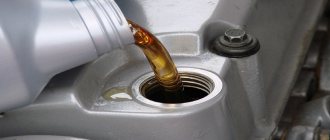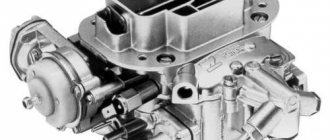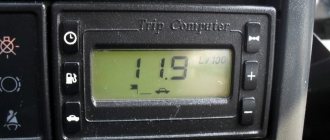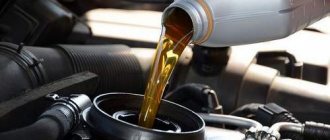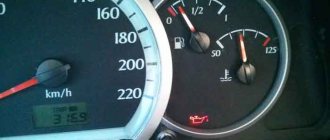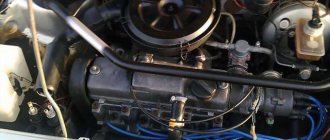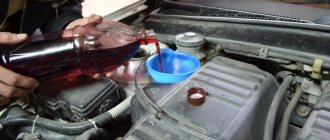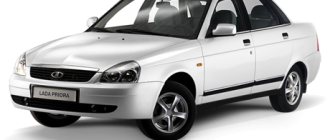Engine oil consumption is determined depending on the amount that burns out in the engine. Excessive consumption of engine oil can indicate either poor quality (the lubricant then burns out excessively) or a malfunction of the engine itself (leakage occurs, most often through valve seals and oil scraper rings). Everything will depend on the specific numbers and additional symptoms that may appear when the lubricating fluid is lost.
How is engine oil consumption calculated?
To determine the norm, it is not the mileage value that is taken into account, but the fuel consumption. This indicator is more accurate than the distance traveled, because when you are stuck in traffic jams, the oil is depleted even more, and the odometer does not change its value.
Engine oil consumption is usually calculated based on the volume spent on burning 100 liters of fuel.
To find out the oil consumption rate in your car's engine, you need to use a calculation formula and a calculator, or use this online form. It involves calculating the permissible amount of oil for waste according to the type of engine, the volume of operating oil and the amount of fuel consumed, taking into account the condition of the piston group.
Calculation formulas for oil consumption
The total actual oil consumption for waste during its operating cycle (from replacement to replacement) can be calculated using the formula:
Qy = ∑q + (Qз-Qсл),
Where ∑q is the oil added during the cycle (between maintenance); Qз - filled during refueling; Qsl – drained during replacement.
But the consumption of poured oil in liters per 100 liters of fuel is determined as follows:
Mз = V / (P*k),
Where V is the capacity of the engine lubrication system; P – consumed fuel k – coefficient taking into account wear of the piston group (k – for a diesel car 1.25; petrol 1.15; turbo 1.3).
Oil consumption rates increase to 20% for vehicles after major repairs and in operation for more than 5 years.
Content
During vehicle operation, the volume of engine oil in the engine lubrication system inevitably decreases. At the same time, it has been noticed that in new generation cars the consumption is higher than in older cars. This is due to an increase in the load on the parts, which is not always proportional to their safety factor. The oil, along with the gases, enters the crankcase area and then into the combustion chamber under the influence of constantly increasing pressure in the cylinders. If the car is equipped with a turbocharger, lubricant consumption increases even more. The turbocharger seals are leaky, and a certain amount of oil necessarily penetrates into the compressor part and further into the cylinders. In addition to the usual waste, excessive consumption of lubricant is often caused by wear of engine parts, leaks, and evaporation. What engine oil consumption is considered normal and how to prevent deviations from the norm?
Engine oil consumption rate for waste
For passenger vehicles, the normal burn rate is 0.005 - 0.025% per 100 liters of fuel, which is approximately 5 to 25 grams of oil per 1 thousand km. In a worn engine it can reach up to 0.1% and 100 g. per 1000 km respectively. Well, if the car operates at the limit or has a turbocharged or diesel unit, then this norm will be even higher.
For long cargo trucks, the oil consumption rate is 0.3 - 0.4% of fuel consumption. The calculation formula uses the amount of fuel burned and oil added during this period. But this calculation of oil consumption, proposed by the automaker Scania, is relevant only for heavy cars with a large engine. Calculations of lubricant consumption in passenger cars, both with diesel and gasoline engines, have a slightly different form.
Engine oil consumption rate per 100 liters. fuel for passenger cars
| engine's type | Acceptable waste | |||
| In percent, % 100 l. fuel | In grams, g per 1000 km | |||
| New | Worn out | New | Worn out | |
| Petrol | 0,005 – 0,025 | 0,025 – 0,1 | 5 to 25 | 25 – 100 |
| Turbocharged | 0,05 – 0,08 | 0,5 – 1 | up to 100 | 100 – 300 |
| Diesel | 0,035 – 0,25 | 0,3 – 0,8 | 30 – 55 | up to 200 |
| Rotary | 0,5 – 1,2 | 1 – 2 | 500 – 1000 | up to 2000 |
For carburetor VAZ cars, the norm is considered to be a consumption of 0.3 to 0.4 liters. per 100 liters of fuel.
A gasoline engine operating at the limit of its capabilities can consume from 0.4 to 0.6% at 100 hp. fuel consumed, which is approximately 400 - 600 grams of engine oil per 1000 km. The situation is exactly the same with diesel engines - engine lubricant consumption increases by 0.5%. But if these are forced turbodiesels with two turbines, then the consumption can reach up to 3% of the volume of oil poured into the engine.
Keep in mind that oil consumption rates increase significantly for cars after major repairs and in operation for more than five years .
The average amount of engine oil consumed by an engine after a run of 150 thousand km is 0.35 - 0.55 liters.
Method for determining oil consumption
Oil level on dipstick
Determination of the actual value of specific engine oil consumption for waste is carried out over a mileage of 200-300 km. The vehicle must be technically sound during the test drive. The oil level in the crankcase should be between the “MAX” and “MIN” marks on the engine dipstick. Before the test run, it is necessary to warm up the engine, the oil temperature should be 80-85°C. Drain the oil on a level surface. It should drain from the pan within 15 minutes. For the accuracy of the result, it is advisable to determine not the volume, but rather the weight, since the amount of lubricant remaining in the filter can only be determined by weighing it.
How to use the calculator
One of the main roles in this calculation is played by the volume of fuel burned and the volume of operating oil, as well as the type of engine. It is in relation to this volume and specifics of work that the specific oil consumption is calculated.
To calculate specific engine oil consumption, the following data is required:
- In the “fuel” field, enter the average fuel consumption in liters per 1`000 km. mileage (by default and based on calculation formulas this is 100 liters);
- In the “oil” field - the volume of oil that is regulated by the manufacturer as necessary when filling;
- Select the engine type and check if the machine has been in use for more than 5 years
- Click "calculate".
Please note that the results of the calculator for calculating the permissible engine oil consumption rate are a general case and for some engines (due to the specific design) may be inaccurate and need to be adjusted.
Such a calculation calculator can be an indispensable assistant for calculating the consumption rate of lubricants intended for operational accounting of the specific consumption of motor oil when justifying the need for them. After all, if not all, then many car enthusiasts have a rather wary attitude towards engine oil consumption. This service will show whether you are within the nominal values. If not, then you will have an objective reason to look for reasons and possible problems.
What's the outcome
That is, if the engine is in order, then it takes practically no oil, and you will not need to top it up until the next change. Its level will be within acceptable limits on the dipstick (within the min./max. marks). But there are cases when the manufacturer indicates consumption rates for a specific power unit (some engines eat oil), then topping it up is considered natural and is not a malfunction, but on average it does not exceed 1-2 glasses from replacement to replacement.
It is important to understand that the harder the engine runs, the more oil it burns. For example, the higher the number of revolutions, the more oil will remain in the cylinders of the car engine. Although we should not forget not only about the operating mode of the engine, but also its design. You should also not neglect the tolerances of motor oils and fill in fuels and lubricants of dubious quality.
BMW
Among Bavarian engines, N series power units produced in the 2000s showed high oil consumption.
The 3 Series and even the 5 Series sedans were equipped with four-cylinder turbocharged units N45 and N46. Later they were used on X3 crossovers. For these engines, by 80,000 km, the valve stem seals wore out. To reduce friction losses, the pistons were made T-shaped, which left little room for the O-rings.
Why do we need motor oils with zero viscosity? More details
FAQ
Formula for calculating oil consumption
Calculation of oil consumption can be carried out on waste, for the cycle of its operation between maintenance and consumption per 100 liters of burned fuel. The formulas for these two calculation options will be different. Engine oil waste from replacement to replacement is calculated by the formula: Qy = ∑q + (Qз-Qсл), where ∑q is the amount of oil added, Qз is the oil that was poured into the engine during replacement, Qсл is the amount of oil that was drained.
To calculate the consumption of the filled oil, which needed to be added only during the period of 100 liters of fuel burned by the car, the calculation formula is: Mз = V / (P*k), where V is the capacity of the entire engine lubrication system, P is the fuel consumed, k is the coefficient piston wear (varies depending on the engine, if diesel, then used - 1.25; gasoline - 1.15; turbo - 1.3).
Calculation of oil consumption per 100 liters of fuel
To calculate oil consumption per 100 liters. fuel, the total volume of the engine oil system (indicated in the technical documentation of the car) must be divided by the product of the spent fuel and the wear rate. So, for example, if 4.7 liters of oil need to be poured into the engine, then with 100 liters of fuel consumed by the engine, 30 grams of oil consumption is allowed. Thus, you can calculate the oil consumption of the engine and your car using the formula.
Engine oil consumption rate per 100 liters. fuel
In a passenger car engine, oil consumption can be considered normal in the amount of 0.005 - 0.0025% per 100 liters. fuel, which is equal to 5 - 25 g per 1 thousand km. The amount of oil required to top up an engine with significant mileage is considered normal even at 0.1% per hundred liters of fuel consumed. If this is a car with a carburetor power system, the permissible figure may be even higher by 0.2%. For trucks, the engine oil consumption rate is within 0.3 - 0.4% of fuel consumption.
The “Oil Pressure” icon is on - reasons
The indicator is inactive when the engine is running and there is sufficient fluid volume. When the oil pressure light comes on, the lubricant level is already critically low. When checking with a dipstick, there may be no traces of liquid left on it at all. Other reasons are low pressure in the engine oil system, failure of the oil level indicator.
The first thing the driver must do is stop the car . Otherwise, after a few kilometers the engine will “die”.
Insufficient fluid level
When the fluid level drops below the permissible limit, the corresponding sensor lights up. The indicator is constantly on. Sometimes the indicator will light up for a few seconds and then go off. This happens when a car is driving up or down the road. Oil overflows to one side of the crankcase, the sensor may react.
Solution to the problem: measure the liquid level and add the required volume.
Incorrect viscosity
The problem is typical for low temperature viscosity. When the lubricant thickens in the cold, the system does not pump it, the pressure drops, and the indicator reacts accordingly. The viscosity of the lubricant changes with use, the oil becomes contaminated and thickens, accordingly, the sensor will indicate the problem.
Solution: use oil of the viscosity recommended by the manufacturer. It is also necessary to change the lubricant in a timely manner; the frequency is indicated in the technical documentation.
Low quality filter
A filter whose design does not have a check valve or does not fully perform the specified function is considered to be of poor quality. It is this that prevents the oil from completely flowing out of the filter. When the fluid completely drains into the oil pan, when the engine starts, the system builds up pressure for some time, as a result of which the parts quickly wear out. The problem is signaled by an indicator that turns on when the car starts, and goes out after a few seconds or minutes.
Dirty filter
As the oil filter becomes dirty, the pressure in the system decreases, the load on the oil pump also increases, and it wears out quickly. The problem will be indicated by an indicator that is active at low or idle speeds.
Solution to the problem: change the oil regularly, use a fluid of suitable viscosity, and also change the oil filter at the intervals specified by the manufacturer.
Oil level sensor is faulty
There are two options. The first is that the light is constantly on because the sensor slider is stuck. This happens when the oil level is too high and the slider “sinks” in it.
The opposite situation happens - the sensor does not respond to the oil level. This means that when the liquid level is critical, the indicator will not light up. You can determine the actual oil level manually using a dipstick.
